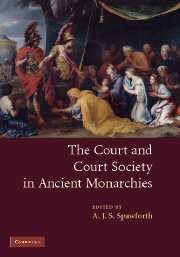Book contents
- Frontmatter
- Contents
- List of figures
- List of tables
- Notes on contributors
- Acknowledgements
- List of abbreviations
- Introduction
- 1 New out of old? Court and court ceremonies in Achaemenid Persia
- 2 King, court and royal representation in the Sasanian empire
- 3 The court of Alexander the Great between Europe and Asia
- 4 Friends in high places: the creation of the court of the Roman emperor
- 5 The imperial court of the late Roman empire, C. AD 300–C. AD 450
- 6 The imperial court in Han China
- 7 Court and palace in ancient Egypt: the Amarna period and later Eighteenth Dynasty
- Bibliography
- Index
2 - King, court and royal representation in the Sasanian empire
Published online by Cambridge University Press: 22 September 2009
- Frontmatter
- Contents
- List of figures
- List of tables
- Notes on contributors
- Acknowledgements
- List of abbreviations
- Introduction
- 1 New out of old? Court and court ceremonies in Achaemenid Persia
- 2 King, court and royal representation in the Sasanian empire
- 3 The court of Alexander the Great between Europe and Asia
- 4 Friends in high places: the creation of the court of the Roman emperor
- 5 The imperial court of the late Roman empire, C. AD 300–C. AD 450
- 6 The imperial court in Han China
- 7 Court and palace in ancient Egypt: the Amarna period and later Eighteenth Dynasty
- Bibliography
- Index
Summary
Introduction
With the exception of the (late) Roman imperial court, theoretical and historical approaches to the princely court as ‘the most general arrangement of power in pre-modern society’ are mostly a phenomenon of medieval and early modern, rather than ancient, history. As for the civilisations of the ancient Near East, here we are more or less treading on virgin ground. Yet the monarchies of the Assyrians, Babylonians, Egyptians, Persians, Parthians and Sasanians stand absolute comparison with their early modern European counterparts in terms of their impact on their subject-populations and neighbours. This does not mean that no scholar until now has ever studied the life, institutions and modes of communication in ancient Near Eastern courts. But such work has seldom been based on a theoretical model or comparison with the court phenomenon in other societies or cultures. As for the Sasanian empire, we do not even possess detailed descriptions or antiquarian studies of the court as a centre of decision-making and governance, as the focus of social networks, as a stage for royal or aristocratic representation, as a centre of consumption, or as a control centre for trans-regional communication. Nor has any expert in the Iranian languages ever addressed the question as to whether there was a Middle Persian or Parthian equivalent of Latin curia, English court or German Hof.
Unfortunately, the specific nature of the Sasanian source material (see below) makes it extremely difficult to rise above the merely descriptive and antiquarian approach.
- Type
- Chapter
- Information
- The Court and Court Society in Ancient Monarchies , pp. 58 - 81Publisher: Cambridge University PressPrint publication year: 2007
- 4
- Cited by

